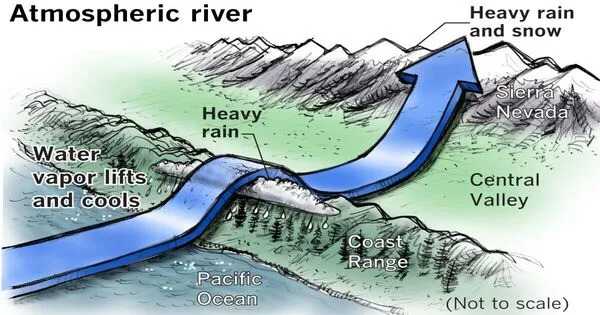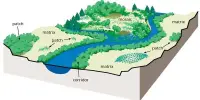An atmospheric river (AR) is a tiny channel or filament of concentrated moisture in the atmosphere. It is a long, narrow stream of moisture in the atmosphere that usually extends thousands of kilometers across the sky. These processes are critical for transporting water vapor from the tropics to higher latitudes, frequently causing significant precipitation in the areas they affect. Other names for this phenomena include tropical plume, tropical connection, moisture plume, water vapor surge, and cloud band.
Atmospheric rivers are narrow bands of accelerated water vapor transport that arise at the margins of broad areas of divergent surface air flow, such as frontal zones associated with extratropical cyclones that form over the oceans.
An atmospheric river is a small corridor of concentrated moisture in the atmosphere that usually stretches thousands of kilometers across the sky. These events move significant volumes of water vapor from the tropics to higher latitudes. They play an important part in the Earth’s water cycle, causing significant rainfall and snowfall when they reach shore.
Importance
Atmospheric rivers can have a substantial impact on weather patterns, particularly in coastal locations where they frequently make landfall, resulting in heavy rainfall and, in some cases, flooding or other weather-related problems. They are especially abundant in the mid-latitudes, such as around North America’s west coast and in Europe, where they can have a substantial impact on regional climate and weather patterns.
Pineapple Express storms are the most commonly represented and recognized type of atmospheric rivers; the name is due to the warm water vapor plumes originating over the Hawaiian tropics that follow various paths towards western North America, arriving at latitudes from California and the Pacific Northwest to British Columbia and even southeast Alaska.
In some parts of the world, changes in atmospheric humidity and heat caused by climate change are expected to increase the intensity and frequency of extreme weather and flood events caused by atmospheric rivers. This is expected to be especially prominent in the Western United States and Canada.
Floods, heavy rains, and even landslides are frequently linked to atmospheric rivers. While they can provide much-needed precipitation to drought-stricken areas, they can also cause disastrous flooding and other hazards, especially if they remain over a region for a lengthy period of time.
Scientists study atmospheric rivers to better understand their behavior and predict their repercussions, allowing communities to prepare for and limit the hazards associated with these strong weather phenomena.
















